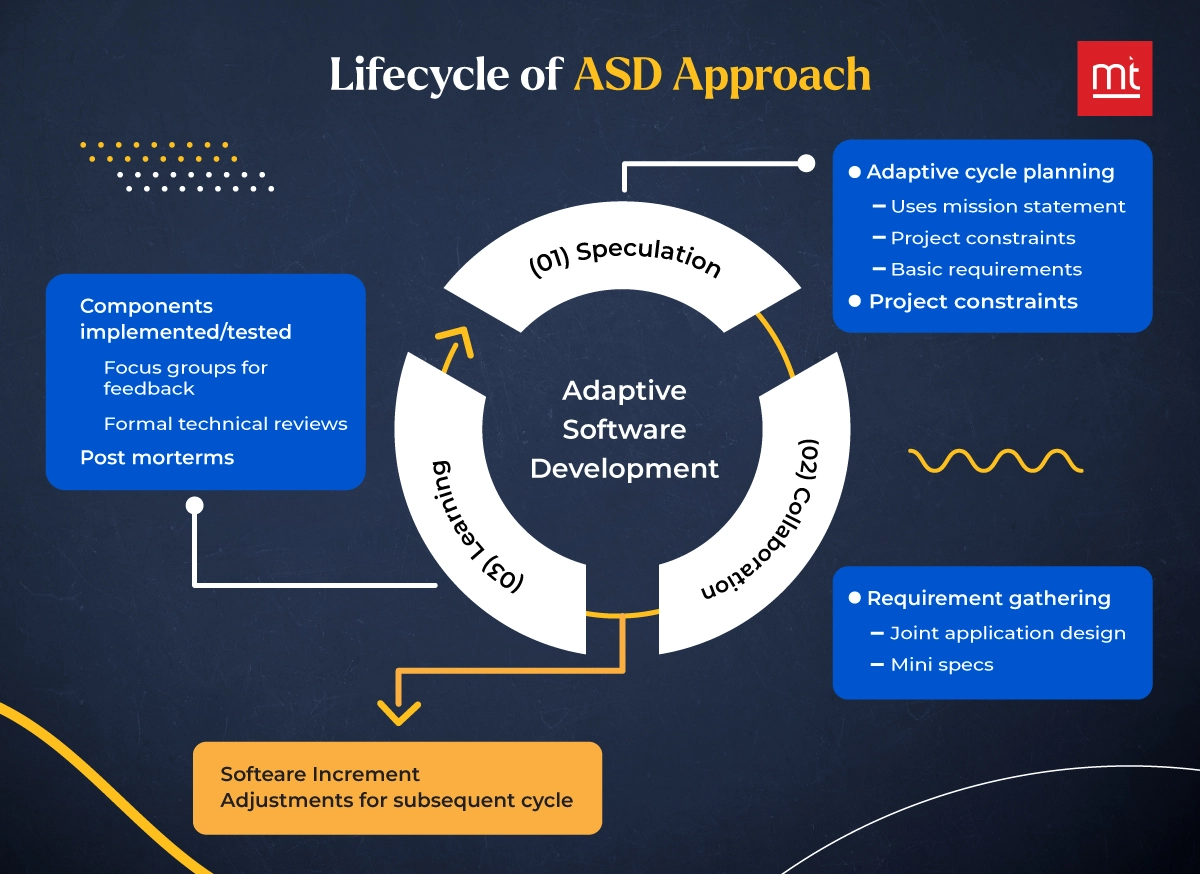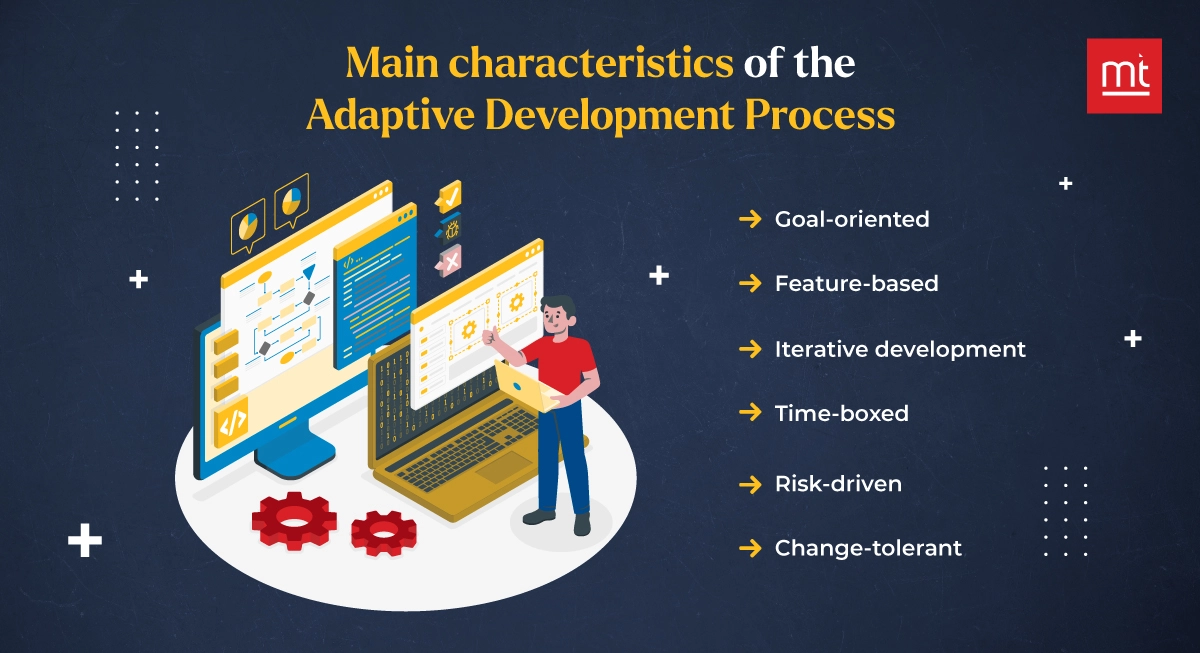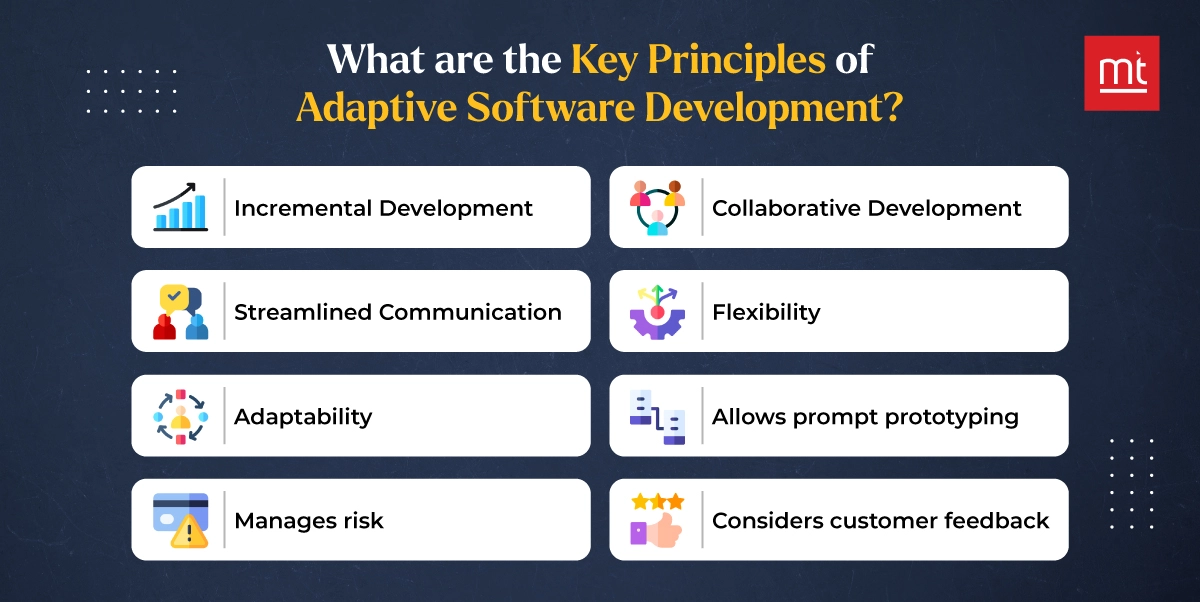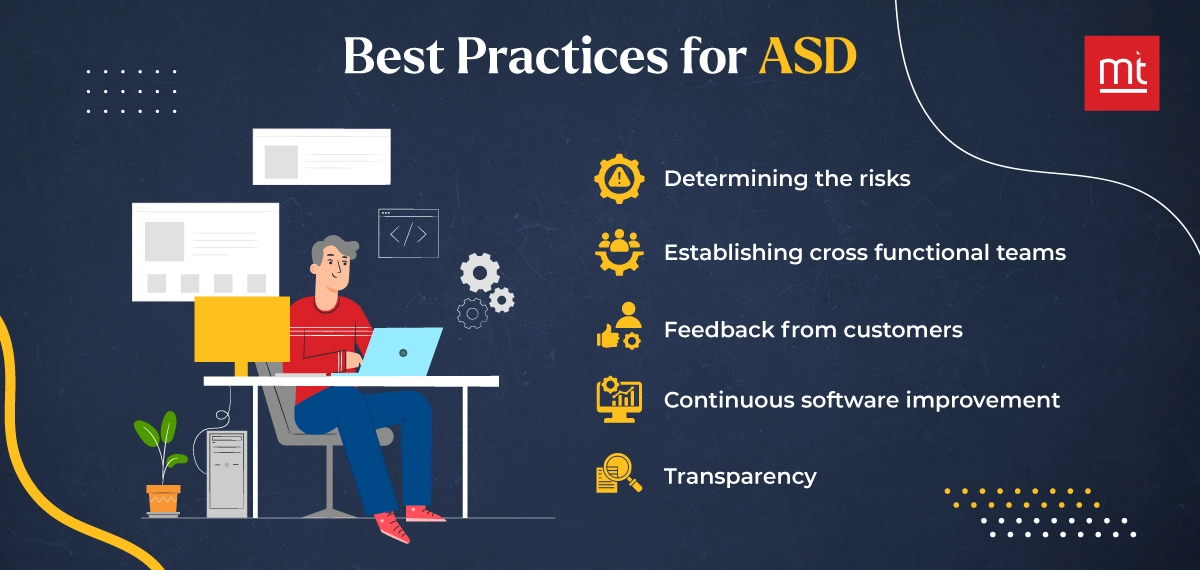Introduction:
Are you eager to embrace digital transformation for your business? According to Statista, the total spending on DT is estimated to reach $3.4 trillion by 2026. With this huge spending, a lot of people like you can ensure seamless collaborations and successful businesses.

Adaptive Software Development approach is a small step toward enabling businesses digitally.
Envision this: Your software is akin to a chameleon that constantly adapts to changing trends. This effortlessness can help you create suave and resourceful code aligned with your goals. It can help your debugging and development teams to tango on the software realm and win each time.
An incredible leap from Rapid Application Development, Adaptive Software Development can ensure continuous learning and constant releases for your code. In this guide, you will learn all about the ASD approach and how to use it for your business transformation.
Overview of ASD
Jim Highsmith and Sam Bayer developed Rapid Application Development, which gave birth to Adaptive Software Development. Most entrepreneurs couldn’t replace the traditional sequential development approach with RAD. As a result, businesses couldn’t adhere to the timelines and failed miserably.
However, ASD took over the reins. It is designed to replace traditional development by adding three elements- speculate, learn and collaborate. You get a chance to understand the issue, identify the solutions and collaboratively solve it. This lightweight yet interesting version of rapid development will accelerate timelines and enable smooth development.
The Lifecycle of ASD Approach
Adaptive software development follows a cyclical model that is evolutionary just like the tech realm. It includes three phases- speculate, collaborate and learn. By following each phase, you can tune your code to the plot twist.

#1. Speculate Phase
Don’t we all speculate about our higher purposes in life? That’s what you need to do in this phase. Speculate the need for a code or application. Identify the ultimate goal of your business application. Do you want it to deliver a tangible or intangible outcome?
So, why don’t we call this a planning or strategy phase? When you are in the adaptive software world, you are talking through volatility. Planning can be very restrictive for you; you need something that can adapt to the fickleness with great ease.
You will build an overall understanding of the project and determine the possible risks. You will also divide the entire project into short yet deliverable iterations.
#2. Collaborate Phase
This is the most crucial phase of adaptive software development. When using this approach to build your software, you need to have an open mind. You need to build an evolving and naturally constructive software solution. It should be able to adapt to the turbulent and ever-changing environments.
Now, can you deliver something like this without knowing or walking into the unknown? Can you do it alone? No! You need people and you must walk into the unknown to deliver the best solution.
Collaboration is where you all sit as a team, think through the problems, analyze the data, and identify opportunities. Once there is collective knowledge, your team can build the solution. collaboration is the premise of this software development methodology.
You must establish critical cross-functional teams and define the communication channels for the best outcomes. You must also plan the communication strategies for the best outcomes.
#3. Learn Phase
Learning is when you conduct an internal review and understand your customer. No software is complete till you understand your employees, teams and the users. To adapt to the transforming landscape, your team must conduct customer research, check the project requirements and learn about technologies.
The idea is to create a prototype to validate the concept and check the customer’s eagerness regarding the solution. Moreover, you can also use this phase to continuously evolve and transform your solution.
Main Characteristics of ASD Process
We have seen how the lifecycle of the software development methodology depends on three critical phases. Let’s look at what are the core elements or features of the methodology.

1. Goal Oriented
Your entire development depends on the specific goals or objectives you outlined at the speculation stage. It is a goal-based process, where your purpose directs the software development.
2. Feature-based
One of the core characteristics of this development method is the feature-driven methodology. The entire process depends on the features you are planning to build. You will take an incremental approach, wherein each phase will cover a set of priority features. You might need to define the feature priority during speculation.
3. Iterative Development
You must take a short incremental route to accomplish your software goals. Each iteration is sequential. The new iteration will add features or functionality to the code derived from the previous cycle.
Using the feedback from the iterative development, you can improve the software and offer responsive solutions.
4. Time-boxed
Time boxing is one of the finest elements of this approach, wherein your iterations are bound by a timeframe. You can use the time limit to complete specific tasks or functions. Using this feature, you can create a sense of urgency and ensure meeting the timelines.
5. Risk-driven
As it is founded on uncertainty, several risks drive this approach to the finish. You will need to proactively identify the issues and ways to mitigate them. Early intervention is the key to assessing and removing the risks. It can also help you overcome unpredictable situations.
6. Change Tolerant
While it is risk-driven, it can adapt to changes with great ease. Your software can change its tunes to meet the new environmental requirements. As it is flexible and responsive, altering the code or creating a solution to meet the new needs is easy.
Benefits of ASD in Software Engineering
Adaptive software development is a flexible and responsive software development approach. Here are all the benefits of implementing this methodology in your project.
- Using this approach, you can respond to the dynamic tech environment. As a result, you no longer need to build or add features that your customers won’t use.
- It allows developers and business teams to learn from the environment. This continuous learning allows you to implement the essential features or feedback from the customers into the application. It enhances your app’s potential.
- You are constantly learning from the tech trends and the users. As a result, you will never release a project or software solution that your users don’t need. This reduces your chances of failing to meet your customer’s requirements.
- Using the iterative approach, this software development approach can deliver functional products in shorter timelines. As a result, you can build usable and feature-driven solutions that extend value to the customers.
- You are constantly connected with the stakeholders of the project. Their feedback can help you build products that meet the business goals and customer expectations.
- For every business owner, collaboration is the key to a successful business. this approach was derived while emphasizing on this aspect. As a result, you gain a more productive and efficient team environment.
- As you are continuously building, testing and adapting the software to the new trends, you can deliver exceptional software quality. It can also help identify the bugs in the early stages and resolve them faster.
- It reduces the documentation overhead as the approach relies on creating functional and practical software solutions.
Limitations of the Adaptive Development Process
Everything in this world has a flip side. So, does your software development methodology seems to be perfect?
- It takes longer to plan your project with this process as compared to others. You might face a complex roadmap that can make it difficult to execute. Moreover, you are dealing with uncertainties, which in itself is a major roadblock.
- It can take up a lot of your resources. You may not have so many in-house, which means you need to outsource or hire more. This looks like a spending zone for you. Beware! Think through it before you choose it.
- It can be resistant to changes. You might need to prepare your team and its members for this change before going ahead with it.
- As you cannot predict the future, you are never really sure of the timelines or the deliverables. It all works on the “suppose” theory, which is never too reliable.
- You cannot create comprehensive documentation in this approach as it relies on flexibility and responsiveness.
- If you don’t have customers, you are doomed for failure. The reason being customers are core to this approach and its success.
Core ASD Principles You Must Know
Here are all the core principles that make this approach unique and engaging for the business and development teams.

Incremental Development
This approach takes the incremental and iterative route. As a result, you get to break down an entire chunk of work into manageable tasks. You can associate a tangible deliverable with each iteration.
At the end of the cycle, you can seek feedback and refine the product before committing the code. It will reduce the risks associated with and simplify the development workflows.
Collaborative Development
It fosters collaborative development, where your cross-functional teams, with unique skills, can connect to complete the project. Using this principle, you can solve problems, remove bottlenecks and enhance the software quality. It will also improve the team’s efficiency and effectiveness.
Streamlined Communication
The software development approach lays excessive emphasis on communication. Communication helps teams with innovative ideas and boosts their abilities. In this approach, the stakeholders can work on defining the communication means and methods in advance.
Moreover, this method can reduce delays and improve information flow. As a result, it can enhance transparency.
Flexibility
Adaptive software development is built for inevitability. This means your code can easily match the evolving environment. It is flexible and can change to the new requirements or circumstances with ease. So, if you are planning to change the scope or the environment grows fickle, your software is ready to march through the door.
Adaptability
The best part about this approach is that you can create more responsive and engaging solutions. They can immediately alter themselves to meet the new conditions or criteria. The teams can anticipate new environments or conditions and enable the responsiveness in the code. This dynamic behaviour will help you create successful solutions.
Allows Prompt Prototyping
As a business owner, you must know what your customer wants. That is possible when you create a solution and validate it. ASD is built for immediate and prompt prototyping. You can envision your product features, help the users learn more about it, and keep improving it for better use.
Manage Risk
This approach anticipates issues, which reduces the risk of failures. You are always prepared for the changing conditions and can manage to meet the new decisions. You are also aware of the new issues and potential problems. Your superpower of knowing everything already can help you predict the solutions as well.
Considers Consumer Feedback
You will always be facilitated with customer feedback. This is pivotal in making informed decisions. Whether it is adding another feature or removing one, you know what your customer wants.
Best Practices for ASD
Using best practices, you can ensure smooth and streamlined implementation of the adaptive software development approach. It helps foster a transformative and collaborative environment.

1. Determining the Risks
Development teams must assess the risks proactively. When you can identify the issues in the early stages, it is easier to fix them. As a result, you can work on risk mitigation strategies.
It is equally important to assess the risks during every iteration. It will help reassess the scope and build your software to the new needs.
2. Establishing Cross-functional Teams
As a business owner, you must have all the skilled resources in a single place for a more adaptive and flexible solution. building cross-functional teams with experts from across silos can give a great twist to your otherwise regular solution. It will enhance communication and help deliver strong and secure software.
3. Feedback from Customers
You must rely on your customer’s feedback to build the ideal solution. They are the end users of your solution. If they have identified an issue or require a solution, you might want to consider including it.
While planning your software, make sure to include loops and ways to get feedback from the customers. It is also an important part of informed decision-making for business owners.
4. Continuous Software Improvement
Your adaptive software development approach is a success when you consider continuous improvement alongside incremental development. You must constantly reflect on what you have built and consider adding the necessary alterations. It is equally important to refine the software as needed. You can use several aspects to induce improvement.
5. Transparency
When your stakeholders have a transparent conversation, you can see your app progressing. It will ensure you achieve your timelines and release the apps faster. Your customers and investors will trust on your abilities and it will strengthen your image.
Successful Products Developed in Adaptive Software Development Lifecycle
Let’s look at some of the successful projects that were built using an Adaptive software development approach.
#1. Microsoft Windows
This flagship OS was created using the adaptive software development approach. As it takes the iterative approach, they could regularly update the software. Moreover, it could easily adapt to the new needs and changing environment. As a result, Windows still remains relevant to the users.
#2. Google Chrome
They were able to attain success and a customer base owing to this incredible development approach. It helped them adapt to the environment and induce rapid changes. Moreover, they were able to deliver regular updates that helped them gain a competitive edge.
#3. Netflix
This streaming platform has used ASD to improve customer feedback implementation and update its platform frequently. It also helped them be more flexible and tango with the evolving tech industry.
#4. Spotify
The incremental development and user feedback offered them the ability to be more responsive. It also helped them ring in improvements to the software solution.
Why Adopt ASD for Your Next Project?
Here are all the reasons to choose the ASD approach despite its limitations.
- You can use iterative and incremental development to accelerate timelines and offer better solutions for your users.
- It can quickly adapt to the changing environment and respond to new needs faster. As a result, you can refine your solutions.
- Using the feedback loops, it can take note of your customer’s requirements. As a result, you can build solutions that are aligned with your customer’s vision.
- You can use all the loops to identify the issues early and debug them faster. It also reduces the rework.
Conclusion
Adaptive software development is a vital change in the technology realm that can enhance the speed and quality of development. Using iterative development and an adaptive approach, you can create flexible and responsive solutions. It is easier to scale with this methodology.
ManekTech is proficient with the ASD process. We can implement the best practices and leverage the core elements to deliver the apt solution. You can outsource development to our team for accelerated timelines.
About Author
Subscribe to Our Newsletter!
Join us to stay updated with our latest blog updates, marketing tips, service tips, trends, news and announcements!






















